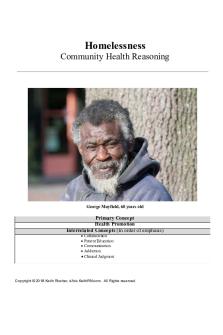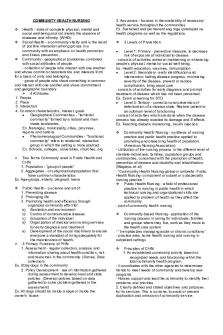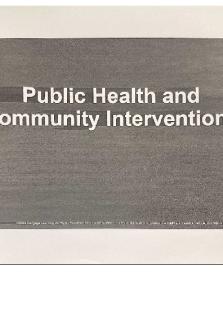ATI Community Health Focus PDF

| Title | ATI Community Health Focus |
|---|---|
| Author | Molly Jensen |
| Course | Faith Based Community Health |
| Institution | Freed-Hardeman University |
| Pages | 24 |
| File Size | 115.6 KB |
| File Type | |
| Total Downloads | 42 |
| Total Views | 179 |
Summary
For ATI Community end of semester test....
Description
ATI Community Health Focus Review Nightingale’s Environment Theory: Emphasized prevention care. Washing hands Sterilizing instruments
Health Belief Model
Assumes that preventive health behaviors are taken primarily for the purpose of avoiding disease. Describes the likelihood of taking an action to avoid disease based on: Susceptibility, seriousness, and threat of disease Modifying factors Demographics Knowledge level Age Race Cues to action Media Disease effect on ppl Recommendations from health care professionals Perceived benefits minus perceived barriers to taking action
Goals of community health nursing:
Promote, preserve, and maintain health of populations by delivery of services to individuals, families, and groups to influence community health Who is the client in community health nursing? The community or population BOTH COMMUNITY ORIENTED NURSING AND COMMUNITY BASED NURSING
Public Health Nursing
Also known as Community-Oriented Nursing Population focused Goal:
Promoting health Preventing disease No illness cares Key Principles: Emphasize primary prevention Greatest good for largest number of individuals Client is partner in health Use resources wisely to promote best outcomes
Community-oriented Nursing:
Focus of Care: Aggregates Communities Populations (public health) At-risk or unserved individuals and families Primary Goal: Health promotion and disease prevention Education Nursing Activities: Indirect (programmed management) Can include direct care of at-risk individuals and populations
Community-based Nursing
Focus of care: Individuals and families Management of acute or chronic conditions Direct (one-on-one) Illness care: School nurse Camp nurse Prison nurse
Ethical principles to community health nursing
Autonomy Nonmaleficence Beneficence Justice
Community Health Education
Obstacles: Age Cultural barriers Poor read comprehension Language Lack of motivation Effective health education requires planning
Learning Styles
Visual Auditory Tactile-kinesthetic
Epidemiological triangle
Agent Causes disease Drugs Toxins Noise Temperature Viruses bacteria Host Being affected Age Gender Genetics Ethnicity Immunological status Physiological state Occupation Environment Physical Environment Geography Water/food supply Presence of reservoirs/vectors Social Environment Access to health care
High-risk working conditions Poverty
Incidence
Number of NEW cases in specific time frame
Prevalence
Number of NEW AND EXISTING cases in specific time frame
Health People 2020
Goals: Based on issues that are considered major risks to health and wellness Educate on DM, cancer, older adult health, and LGBT health
Primary Prevention
Prevent initial occurrence of disease or injury Education Immunizations Advocation for access to health care
Secondary Prevention
Early detection Limiting severity Screenings Disease surveillance Control of outbreaks
Tertiary Prevention
Maximize recovery after an injury or illness Rehabilitation Case management Support groups Nutrition counseling for management of Crohn’s disease.
When to assess cultural beliefs and practices? When developing plan of care
Acculturation Process of merging with or adopting the traits of a different culture
Ethnocentrism
Belief that your current beliefs or cultural is superior and better
Cultural Assessment Parameters
Ethnic background Religious preferences Language and literacy needs Communication needs Education Cultural values Food patterns Health practices Always include pt preferences in assessment/plan of care
Using an interpreter
They should have knowledge of health-related terms NEVER use family members Consider preferences of age and gender Should NOT be from same community as pt
Environmental Risks
Toxins Lead Pesticides Asbestos Radon Air pollution Carbon monoxide Tobacco smoke Lead Sulfur dioxide Water pollution Wastes Erosion after mining Run-off from chemicals added to soil Contamination Food and food products with bacteria, pesticides, radiation, and meds
Key questions for health history
What is the condition of the residence? Age and location What is the pt’s occupation? Do you smoke in the home? Are you exposed to second-hand smoke? What is the source/quality of drinking water? Is there any presence of mold or fungi? What temperature is the water heater set on? Should be 65 y.o and receiving Social Security/disability for 2 yrs Part A Hospital care Home care Hospice Limited skilled nursing care for 100 days/yr Part B Health care provider Outpatient care Home health Diagnostic services Physiotherapy Durable medical equipment Ambulance service Mental health Preventive services Part C Known as Medicare Advantage Plan Combination of A & B Provided through private insurance Part D Prescriptions THINK D FOR DRUGS
Medicaid
Provides health care to pt’s of low socioeconomic status and children through the combined efforts of federal and state governments Eligibility based on: Household size Income Priority given to children Pregnant Disability
State Health Agencies
State department of health Manages WIC Oversees CHIP Provides health coverage to uninsured children Responsible for administration of Medicaid program Reports communicable diseases within state to CDC State boards of nursing Development and oversight of state’s nurse practice act Licensure of RN and LPN Oversight of state’s schools of nursing
Community assessment components People Demographic Distribution Mobility Density Census data Biological factors Health and disease status Genetics Race Age Gender Cause of death Social factors Occupation
Activities Marital status Education Income Crime rates Recreation Industry Cultural Factors Ethnohistory Hierarchy Language Religion Values Customs Norms Place or environment Physical factors Geography Terrain Community Location of health services Housing Animal control Environmental factors Geography Climate Flora Fauna Topography Toxic substances Vectors Pollutants
Data Collection
Informant interviews Direct discussion Community forum
Open public meeting Secondary data Existing data Death stats Birth stats Census data Mortality Morbidity Health records Prior health surveys Participant observation Observation of formal or informal community activities Focus groups Directed talk with a representative sample Surveys Specific questions asked in a written format Windshield surveys Descriptive approach that assess several community components by driving through a community Survey Components What is their general appearance? Age Dress Well-nourished Obese Frail Unkept What is the origin, ethnicity, or race of people? Is there any evidence of substance use, violence, disease, mental illness? Is there easy access to health care? Are there grocery stores which provide fresh produce, or is this a “food desert”? Is the housing of acceptable quality? Is the housing in good repair or not? Is there vacant housing?
Is there public transportation? What grocery stores or other stores within community?
Preplanning
Brainstorming
Assessment
Collect data
Diagnosis
Prioritize health needs of the community Analyze data to determine health needs
Planning
Develop interventions to meet identified outcomes Establish goals and objectives for the selected solution Identify who will assume responsibility for each intervention Determine funding opportunities for needed intervention and develop budgets
Implementation
Carry out the plan
Evaluation
Examine the success of the interventions Determine achievement of desired outcomes
Lead Poisoning Important to ask a pt when house was built? ...
Similar Free PDFs

ATI Community Health Focus
- 24 Pages

ATI Community Health Study
- 22 Pages

Community Ati questions
- 12 Pages

Community health final
- 14 Pages

Community Health Nursing RLE
- 15 Pages

Community Health Diagnosis
- 136 Pages

Community B docx - ati
- 12 Pages

Community Health Nursing Kaplan
- 41 Pages

Community Proctored ATI
- 13 Pages
Popular Institutions
- Tinajero National High School - Annex
- Politeknik Caltex Riau
- Yokohama City University
- SGT University
- University of Al-Qadisiyah
- Divine Word College of Vigan
- Techniek College Rotterdam
- Universidade de Santiago
- Universiti Teknologi MARA Cawangan Johor Kampus Pasir Gudang
- Poltekkes Kemenkes Yogyakarta
- Baguio City National High School
- Colegio san marcos
- preparatoria uno
- Centro de Bachillerato Tecnológico Industrial y de Servicios No. 107
- Dalian Maritime University
- Quang Trung Secondary School
- Colegio Tecnológico en Informática
- Corporación Regional de Educación Superior
- Grupo CEDVA
- Dar Al Uloom University
- Centro de Estudios Preuniversitarios de la Universidad Nacional de Ingeniería
- 上智大学
- Aakash International School, Nuna Majara
- San Felipe Neri Catholic School
- Kang Chiao International School - New Taipei City
- Misamis Occidental National High School
- Institución Educativa Escuela Normal Juan Ladrilleros
- Kolehiyo ng Pantukan
- Batanes State College
- Instituto Continental
- Sekolah Menengah Kejuruan Kesehatan Kaltara (Tarakan)
- Colegio de La Inmaculada Concepcion - Cebu






